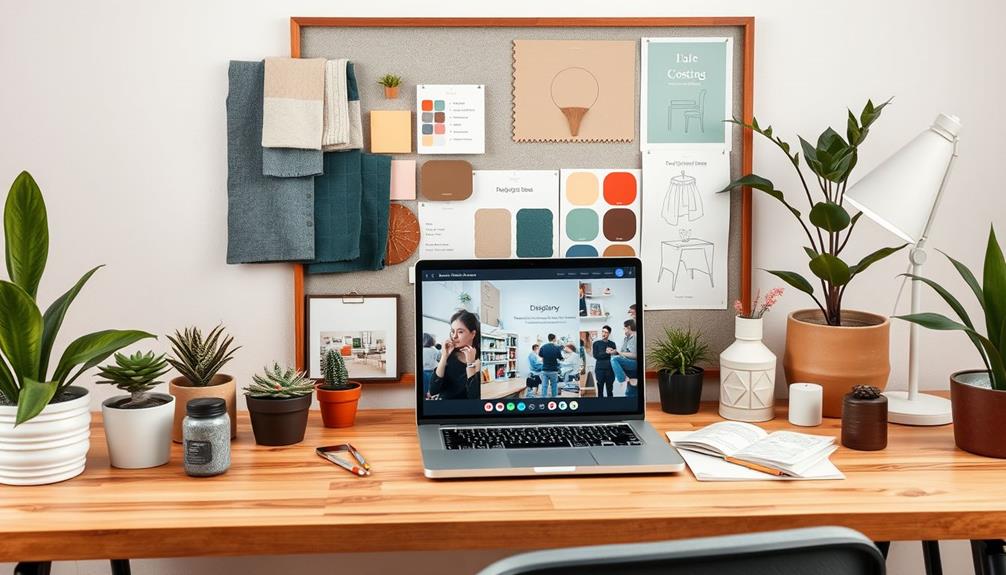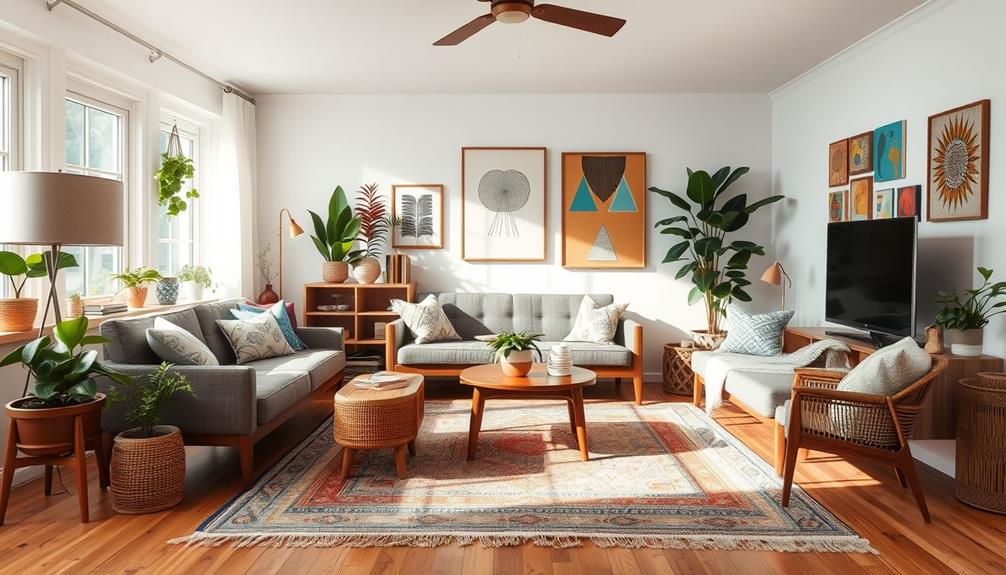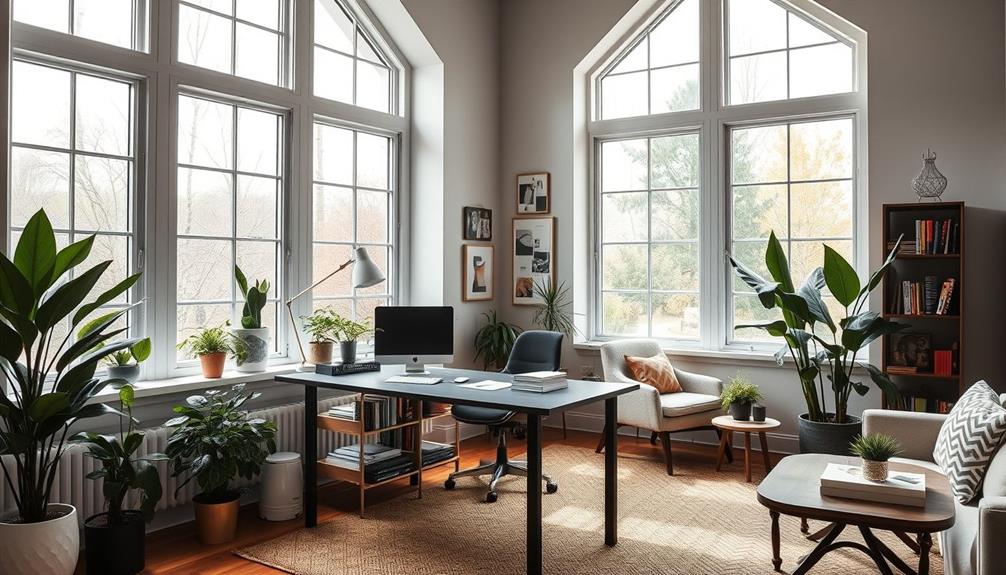You can create an impressive interior design portfolio, even without formal experience. Start by showcasing personal projects like room makeovers to reflect your unique style. Use design tools like HomeByMe to develop compelling visuals. Remember to document your design process with before-and-after photos to illustrate your growth. Networking is essential—attend design events and volunteer for community projects to build experience. Incorporate high-quality images and testimonials to enhance credibility. Finally, keep your portfolio updated to track your evolving style. There's so much more to explore that can help elevate your portfolio even further! Consider starting your own interior design business to further grow your portfolio. This will give you the opportunity to work with clients and gain real-world experience. As you take on projects, remember to document the process and outcomes to add to your portfolio. This hands-on experience will not only enhance your portfolio but also give you valuable skills and knowledge in the industry.
Key Takeaways
- Showcase personal projects like home redesigns or room makeovers to reflect your unique style and creativity.
- Utilize free design tools such as HomeByMe or SketchUp to create and present conceptual designs.
- Document your design process with before-and-after photos and sketches to illustrate your growth and problem-solving abilities.
- Participate in community projects or collaborate with friends and family to gain experience and content for your portfolio.
- Regularly update your portfolio with new projects and seek constructive feedback from peers to enhance your skills.
Types of Portfolios

When it comes to creating an interior design portfolio, understanding the different types available is essential for showcasing your work effectively. You'll find that each portfolio type serves a unique purpose, catering to various stages in your career.
A Graduate Portfolio is vital for students, emphasizing academic projects and skills you've gained during your studies—great for job applications right after graduation.
On the other hand, a CV Portfolio focuses on professional work, tailored to specific job applications. It highlights your relevant experience and design capabilities, giving potential employers a clear picture of what you bring to the table.
For those looking to attract paying clients, a Professional Portfolio is the way to go. This type can come in various digital formats, such as websites, Instagram accounts, or platforms like Behance, providing you with greater visibility and easier sharing of your designs.
Regardless of the type, all portfolios should include essential components—visual examples, a skills list, personal branding, social proof, and contact information—to effectively communicate your identity and expertise as a designer.
This way, you can truly showcase your work and stand out in the competitive design industry.
Building Your Portfolio

To build an impressive interior design portfolio, start by showcasing personal design projects that reflect your unique style, such as home redesigns or room makeovers. Incorporating elements of modern farmhouse bedrooms can add a touch of cozy sophistication to your projects. These initial pieces create a solid foundation for your portfolio.
Use platforms like HomeByMe or other free design tools to develop and present conceptual projects, allowing you to show off your design vision and skills.
Document your design process through before-and-after photos and sketches. This not only illustrates your growth but also highlights your problem-solving abilities in real-life scenarios.
Collaborating with friends or family on small design projects can also help you gain practical experience while creating portfolio pieces that embody your aesthetic.
As you compile your work, aim to create a cohesive narrative that showcases your design skills and unique perspective.
Don't hesitate to seek feedback from peers or mentors; their insights can refine your presentation and enhance the effectiveness of your portfolio.
Creative Project Ideas

Transforming a small space can spark creativity and showcase your design skills effectively. Start by utilizing personal spaces, like your home or a friend's, to create design projects that highlight your style and problem-solving abilities.
For instance, consider incorporating elements from the latest Modern Farmhouse Decor Trends to create a warm and inviting atmosphere. Capture before-and-after photos to document each transformation, providing visual proof of your work for your interior design portfolio.
You can also develop conceptual projects using free design tools such as SketchUp or HomeByMe. These platforms let you experiment with layouts and styles, allowing you to refine your design sensibilities without needing actual clients.
Consider collaborating with friends or family on design tasks, like redecorating a room or rearranging furniture. This hands-on experience not only helps you practice your skills but also generates valuable content for your portfolio.
Don't forget to create mood boards or inspiration collages that illustrate your design aesthetic and thought process. These visual representations provide insight into your creativity, even when you haven't completed a physical project.
Lastly, participating in local community projects or volunteering for design-related tasks can yield tangible results and valuable experience to bolster your portfolio.
Networking for Opportunities

Building a strong network can greatly enhance your opportunities in interior design. Start by attending local design events, workshops, and exhibitions where you can meet industry professionals and potential clients. Personal connections often lead to project opportunities, so make the most of these interactions.
Join online forums and social media groups focused on interior design. These platforms are perfect for networking with peers and seeking mentorship, providing valuable insights and leads on projects. Utilize LinkedIn to connect with experienced designers, share your interests, and express your enthusiasm to collaborate or learn from their expertise.
Consider volunteering for community projects or non-profit organizations that need design services. This not only helps you build your portfolio but also expands your network considerably.
Plus, don't hesitate to ask friends, family, and acquaintances for referrals. Word-of-mouth recommendations can lead to your first paid opportunities in the field.
As you navigate your design journey, remember that effective networking can open doors you never expected, allowing you to grow and thrive as an interior designer. Embrace these opportunities, and watch your portfolio flourish!
Valuing Your Work

Valuing your work is essential for establishing your credibility and professionalism in the interior design industry. As you begin your journey, it's important to recognize the effort and education that goes into your design degree. This acknowledgment reinforces the need for fair compensation for your services.
When you undervalue your work or accept unpaid projects, you risk creating a culture where design is seen as a hobby rather than a legitimate profession.
To maintain your professional standards, set clear boundaries on how many unpaid projects you'll undertake. This not only helps you avoid unpaid work but also positions you as a serious designer in the eyes of clients.
Clear communication with friends and family is significant when taking on projects. Let them know your intentions and the importance of compensation for your work.
Continuous Improvement Strategies

To keep your portfolio fresh and relevant, regularly update it with new projects that showcase your evolving skills.
Don't hesitate to seek constructive criticism from peers and mentors; their insights can help you identify areas for improvement.
Attending design workshops can also provide you with valuable experience and inspiration to enhance your portfolio.
Regularly Update Portfolio
Regularly updating your portfolio is essential for showcasing your latest skills and design style, ensuring potential clients see your most impressive work.
As a new designer, you want to create small yet impactful projects that highlight your growth. Aim to refresh your portfolio at least once a year to include new projects, techniques, and trends that reflect your evolving design vision.
Including recent before-and-after photos can effectively illustrate the impact of your design work, demonstrating the value you bring to an interior design firm. This visual evidence of your capabilities can greatly enhance your body of work.
Pay attention to which projects resonate most with your audience by utilizing social media insights and engagement metrics. This data will guide your updates and help you curate a portfolio that truly represents your strengths.
Don't hesitate to revisit and refine your portfolio regularly; this practice not only keeps your work relevant but also showcases your commitment to continual improvement.
Seek Constructive Criticism
Updating your portfolio is just one part of the journey; seeking constructive criticism is equally important for your growth as a designer. Actively seek feedback from peers, mentors, or industry professionals to identify areas for improvement in your portfolio. Gaining different perspectives on your work can illuminate aspects you may overlook.
Join design forums or social media groups where you can share your portfolio and solicit constructive criticism from a community of like-minded individuals. This exchange of ideas not only enriches your understanding but also fosters connections within the design world.
Schedule portfolio review sessions with experienced designers who can offer insightful advice on both content and presentation, helping you refine your work.
Incorporate feedback into a systematic review process. Regularly assess and update your portfolio based on the critiques you receive and evolving design trends. Document the changes made in response to feedback to track your development over time.
This practice showcases your ability to adapt and grow as a designer, proving that you value improvement and are committed to enhancing your skills. Embrace constructive criticism; it's a powerful tool for your journey in interior design.
Attend Design Workshops
Attending design workshops can be a game-changer for your interior design journey. These hands-on experiences equip you with practical skills you can immediately apply to your projects, helping you build an interior design portfolio that stands out.
Workshops often feature industry professionals who share valuable insights into techniques and trends that are shaping the field today.
Participating in these workshops also opens up networking opportunities. You'll connect with peers and mentors who could provide future collaboration or referral opportunities, boosting your career potential.
Many workshops focus on collaborative projects, allowing you to gain experience working in teams, showcasing your ability to contribute effectively to a group dynamic.
Continuous learning through workshops not only enhances your design skills but also builds your confidence. As you update your portfolio with new projects inspired by what you've learned, you'll be better equipped to present your work compellingly.
Showcasing Your Work

Your portfolio is the heart of your interior design identity, showcasing your unique style and skills.
It's essential to effectively show your work, even without professional experience. Here are four key elements to include:
- High-Quality Images: Use images of your personal projects, like home redesigns or styled corners. This helps create a strong visual impact and exemplifies your design capabilities.
- Before-and-After Photos: Document your design process to show your thought process and transformation skills. This gives insight into how you tackle challenges and achieve a finished product.
- Mood Boards and Sketches: Create these to visually communicate your concepts and design ideas. This illustrates your creativity and planning abilities, engaging viewers with your vision.
- Testimonials: Include positive feedback from friends or family who've experienced your design work. Their insights can enhance your credibility and showcase your work's impact.
Utilizing platforms like Instagram or Behance can further amplify your designs, allowing you to reach a wider audience.
Tools for Portfolio Creation

Creating a standout interior design portfolio doesn't just rely on the work you showcase; the tools you use to assemble and present it play a significant role, too. Start by utilizing graphic design software like Adobe InDesign or Canva. These programs help you create a visually appealing layout that effectively highlights your projects.
Consider incorporating stylish elements like wall clocks to enhance the aesthetic of your portfolio.
Next, explore online portfolio platforms such as Behance and Wix. They offer user-friendly templates that make sharing and gaining visibility for your designs easy and efficient.
Don't skimp on quality—invest in professional photography services to capture high-quality images of your work. Clear, detailed images will showcase your craftsmanship and design details beautifully.
Before adding photos to your portfolio, refine them with photo editing tools like Lightroom or Photoshop. Enhancing your images will elevate their visual appeal and professionalism.
Finally, leverage cloud storage solutions like Google Drive or Dropbox to keep your portfolio materials organized and easily accessible for sharing.
Conclusion
In your journey to jumpstart your interior design career, remember that practice and passion pave the path to success. By piecing together a polished portfolio, pursuing projects, and promoting your skills, you'll transform your talent into a tangible treasure. Don't forget to network and nurture connections, as they can open doors to delightful opportunities. Keep cultivating your creativity, and watch your design dreams flourish. With determination and dedication, you'll design your destiny!







